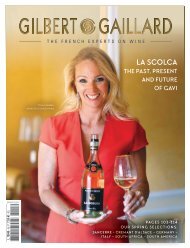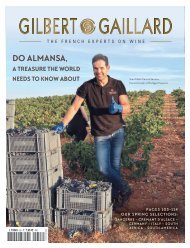FRA_GG_N46-WEB
The GILBERT & GAILLARD International Magazine : Make some room in your lounge for WINE REGIONS from around the world
The GILBERT & GAILLARD International Magazine :
Make some room in your lounge for WINE REGIONS from around the world
Create successful ePaper yourself
Turn your PDF publications into a flip-book with our unique Google optimized e-Paper software.
ITALY<br />
– NEW APPELLATION –<br />
In actual fact, many Prosecco companies were already<br />
producing the pink version with considerable success,<br />
even without stating the name ‘Prosecco’ on the<br />
label. For this very reason, the Consortium decided to<br />
regulate the production of rosé, thereby enhancing its<br />
quality and recognisability, with positive effects on the<br />
perception of the region and the other types of Prosecco.<br />
Rosé production conditions require that only Glera (85 -<br />
90%) and Pinot noir (10 - 15%) grapes be used, fermented<br />
as red wine. Also, on the label the term ‘Millesimato’ is<br />
mandatory, followed by the reference vintage of at least<br />
85% of the grapes. Initially, the indigenous Raboso grape<br />
(in Veneto) and Refosco (in Friuli) were considered for<br />
the blend.<br />
The production area matches that for DOC Prosecco,<br />
which is located in north-eastern Italy and more<br />
specifically in 5 provinces in Veneto (Treviso, Venice,<br />
Vicenza, Padua, Belluno) and 4 in Friuli Venezia Giulia<br />
(Gorizia, Pordenone, Trieste and Udine). When the grape<br />
harvest, winemaking process and bottling take place<br />
entirely in the provinces of Treviso and Trieste, the special<br />
statement of Treviso or Trieste may be used to emphasise<br />
the historical value of the two provinces.<br />
The rosé version must be produced entirely by natural<br />
fermentation in autoclaves with a winemaking period<br />
of at least 60 days. During this period, the yeast can<br />
release compounds such as mannoproteins, which have<br />
positive effects on colour and effervescence and increase<br />
sensory and taste complexity. The colour is a pale pink<br />
which varies in intensity, glistens and displays consistent<br />
bubbles. The aroma is fine, characteristic and typical of<br />
the original grapes. Alcohol content must be at least 11%<br />
vol. and minimum total acidity is 4.5 g/l, with a minimum<br />
non-reducing extract of 14.0 g/l.<br />
In its first year of production, rosé Prosecco was a<br />
resounding success. In just 9 months, 54.2 million bottles<br />
were produced out of a total 425.5 million of DOC<br />
Prosecco. Its current share of 13% of total production<br />
underscores the relevance of the project and demonstrates<br />
the growing trend worldwide for rosé wines.<br />
Here, we review a selection of the most significant Prosecco<br />
wineries to demonstrate the growth of the rosé category.<br />
Prosecco Rosé offers great versatility in terms<br />
of food and wine pairing, something which<br />
Cantina La Marca seeks to capitalise on<br />
Perfect clusters of Glera grapes grown by one of the 400 members of the<br />
Montelliana winery<br />
WINTER 2021 GILBERT & GAILLARD - THE FRENCH EXPERTS ON WINE 101

















